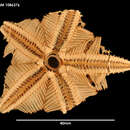en
names in breadcrumbs


“HYMENASTER SACCULATUS, n. sp.
Marginal contour stellato-pentagonoid; interradial indentation small; rays usually recurved dorsally, making the dorsal area deeply concave, the ventral being convex. Minor radial proportion 66.6 per cent.; R=42 millim., r= 28 millim. Radii tapering somewhat sharply at the extremities; marginal fringe distinct and well-developed.
Supradorsal membrane thick and coriaceous in appearance. Papillae numerous, crowns with rarely more than 4 or 5 spinelets, which are prominently protrusive of the membrane,—that portion lying between the tips of each individual crown being thick, devoid of spiracula, and forming a slightly distended saccular area. Thick bands of tissue, with fibres, radiate between the crowns; and the narrow interspaces are occupied by numerous small spiracula, generally three or four, or even more, in line together, separated only by very fine, thin dissepiments. Oscular orifice large; valves 5 in number, regular, and forming, when closed, a compact exactly fitted pyramid, rising as a small cone in the centre of the concave dorsal area. The spinelets of the valves are of moderate length, thickly webbed, and with numerous spiracula in the interspaces.
Ambulacral furrows moderately wide, very uniform in breadth, except towards the extremity, where they taper rapidly, and near the mouth, where they are also somewhat constricted. Ambulacral spines 2, of moderate length, but with a very long sacculate investing membrane; the pairs standing slightly oblique to the median line of the ray. Aperture-papillae large, thickly invested, subspatulate, slightly constricted near the outer third.
Mouth-plates elongate, largely keeled, prominent aborally, each plate bearing two short, thick, dumpy secondary surface-spines—one near the adoral extremity, and the other, of similar size and character, standing behind this, about midway on the surface of the plate. Mouth-spines 4, small, short, conical, on the lateral margin of the plate, ranged serially above and behind the anterior pair of spines just mentioned, and interlocking with the corresponding spines of the neighbouring mouth-angle.
Actino-lateral spines numerous and very closely placed, the longest spine far out upon the ray,—a much greater number being included within the disk-angle than usual. About 40 spines stand on each side of a ray, the 20th or 21st from the mouth being longest. The spines within the disk are comparatively short and uniform in length, and do not quite meet in the median interbrachial line; muscular fibres, however, may frequently be seen underlying the outer tissue, passing from the tips of the lateral spines to the corresponding ones of the neighbouring ray. In the immediate arm-angle, however, the spines are longer than the space between the angle and the furrow; so that a considerable overlap takes place, and a consequent puckering and deformity of the tissue ensues, which appears to develop frequently into an unsightly excrescence. The spinelets succeeding to the long ones taper very rapidly in size towards the extremity of the ray.
Colour, in alcohol, brownish white or grey.
Station 158. Lat. 50° 1' S., long. 123° 4' E. Depth 1800 fms.; bottom temperature 0.3° C.; Globigerina-ooze.”
(Sladen, 1882: 217-218)